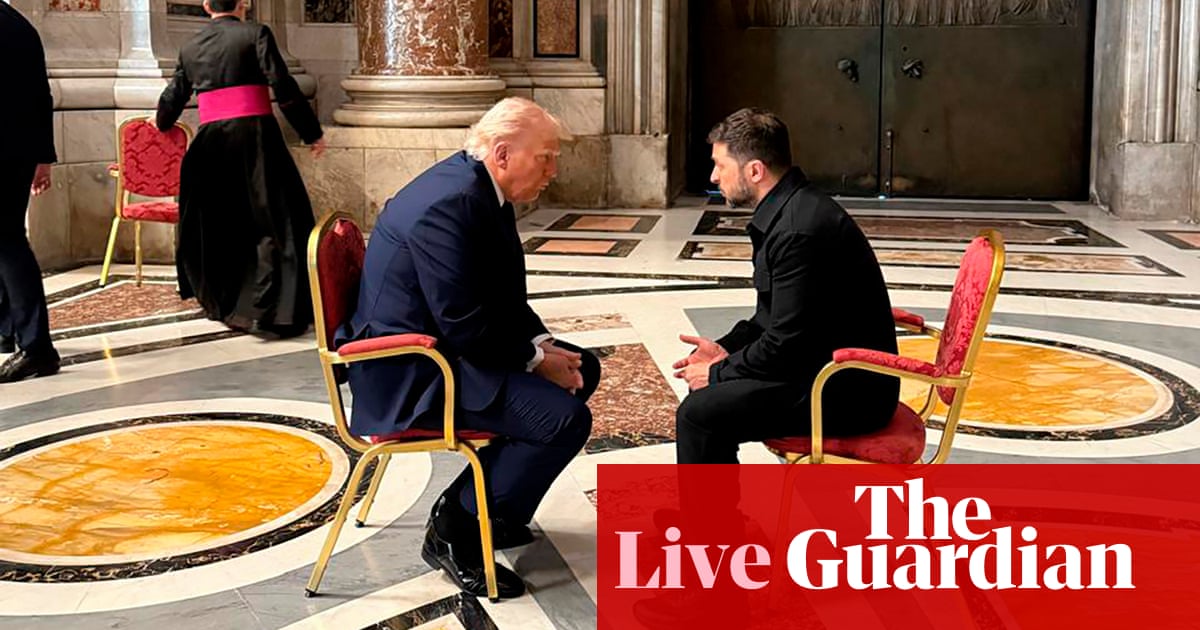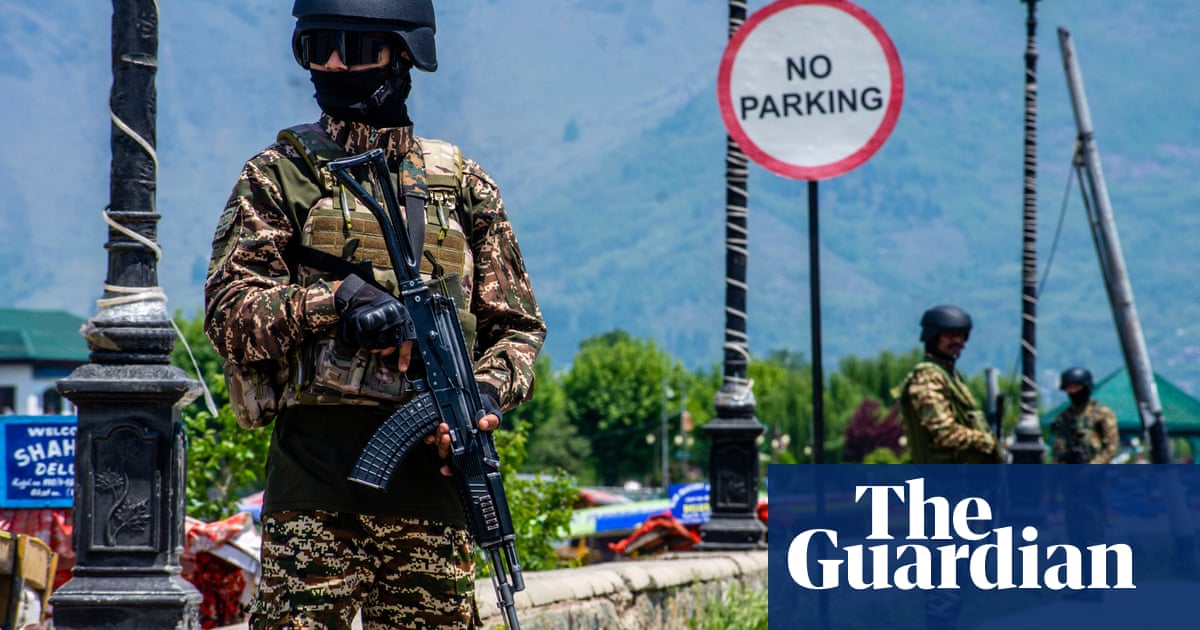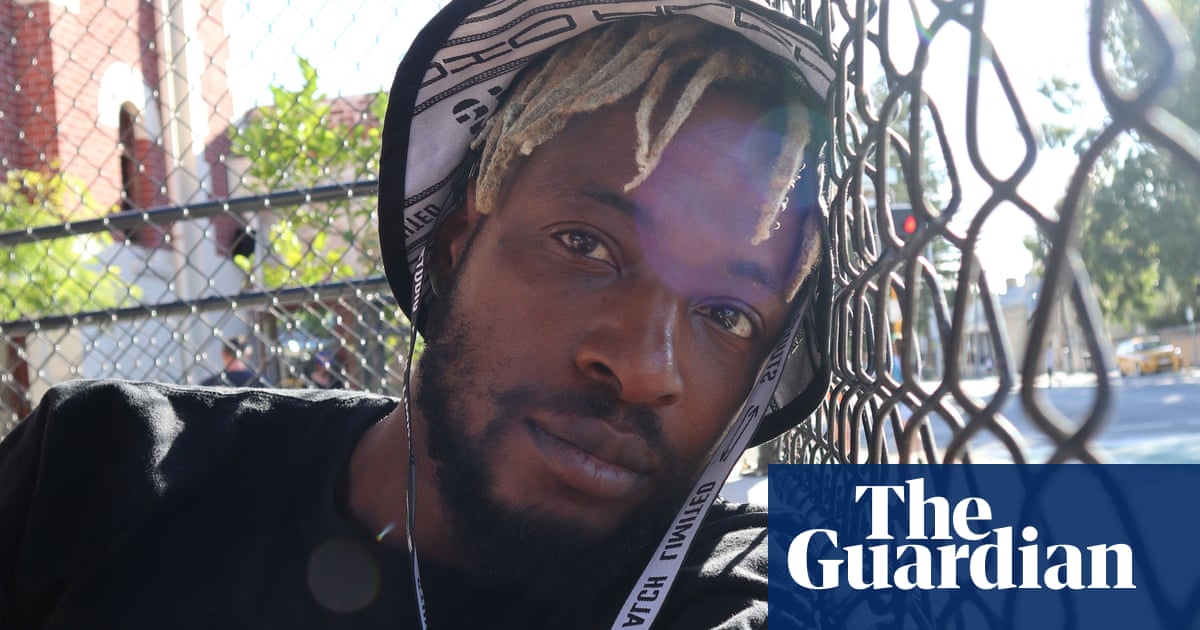Funeral mass ends and procession of pope’s coffin to Santa Maria Maggiore begins
The funeral mass for Pope Francis has ended and now his coffin will be carried in a procession to the Santa Maria Maggiore Basilica in Rome for burial.
As the route map shows below, the procession will leave Vatican City and pass over the Tiber River and then through central Rome to Piazza Venezia, passing by the Colosseum, before turning northward to arrive at Santa Maria Maggiore.
The burial inside the church will not be open to the public.
Key events
More than 250,000 people at Pope Francis’s funeral, says Vatican
More than 250,000 people assembled at St Peter’s Square for the funeral of Pope Francis, the Vatican said on Saturday.
“The competent authority informs us that, while the funeral of Pope Francis has ended, more than 250,000 people are present,” said the Vatican in a brief statement Saturday at the end of the ceremony.
Where will Pope Francis be buried?
Sam Jones
Pope Francis’s choice of burial place marks another break with tradition. Most popes have decided to be laid to rest in the grottoes beneath St Peter’s. But Francis opted instead for the Santa Maria Maggiore Basilica in Rome’s Esquilino neighbourhood, which lies outside the Vatican.
The Marian shrine, which houses a celebrated icon of the Virgin Mary and a relic of the manger in which baby Jesus was laid, was a favourite spot of Francis’s, and he often prayed there before and after his trips abroad.
“As I’ve always promised the Virgin, the place is already prepared,” he said in an interview with Mexican TV two years ago. “I want to be buried in Santa Maria Maggiore because it’s my great devotion.”
Francis requested that he be buried “in the ground, without particular decoration” but with the inscription of his papal name in Latin: Franciscus.
Funeral mass ends and procession of pope’s coffin to Santa Maria Maggiore begins
The funeral mass for Pope Francis has ended and now his coffin will be carried in a procession to the Santa Maria Maggiore Basilica in Rome for burial.
As the route map shows below, the procession will leave Vatican City and pass over the Tiber River and then through central Rome to Piazza Venezia, passing by the Colosseum, before turning northward to arrive at Santa Maria Maggiore.
The burial inside the church will not be open to the public.

Lorenzo Tondo
Pope Francis announced his pastoral intentions from the very beginning of his papacy, saying he preferred a church that was “bruised, hurting and dirty” from being on the streets to one that was cautious and complacent.
Although he never strayed from doctrine – to the annoyance of many optimistic liberals – his 12 years as pope were marked by a deliberate embrace of those historically on the margins of the church and society. He wanted a church, he said, for “todos, todos, todos” – which translates into: “Everyone, everyone, everyone.”
Lorenzo Tondo, Harriet Sherwood and Sam Jones have spoken to those who met him and shared what his pontificate meant to them. You can read their stories here:
In his homily, Cardinal Giovanni Battista Re’s also spoke about how Pope Francis’s papacy was defined by compassion for refugees:
His gestures and exhortations in favour of refugees and displaced persons are countless. His insistence on working on behalf of the poor was constant. It is significant that Pope Francis’ first journey was to Lampedusa, an island that symbolises the tragedy of emigration, with thousands of people drowning at sea.
In the same vein was his trip Lesbos, together with the Ecumenical Patriarch and the archbishop of Athens, as well as the celebration of a mass on the border between Mexico and the United States during his journey to Mexico.
Of his 47 arduous apostolic journeys, the one to Iraq in 2021, defying every risk, will remain particularly memorable. That difficult apostolic journey was a balm on the open wounds of the Iraqi people, who had suffered so much from the inhuman actions of Islamic State.
It was also an important trip for interreligious dialogue, another significant dimension of his pastoral work. With his 2024 apostolic journey to four countries in Asia-Oceania, the pope reached “the most peripheral periphery of the world.”
Pope Francis always placed the Gospel of mercy at the centre, repeatedly emphasising that God never tires of forgiving us. He always forgives, whatever the situation might be of the person who asks for forgiveness and returns to the right path.
He called for the Extraordinary Jubilee of Mercy in order to highlight that mercy is “the heart of the Gospel.”
Mercy and the joy of the Gospel are two key words for Pope Francis.
Pictured: Trump and Zelenskyy speak on sidelines of pope’s funeral
Donald Trump and Volodymyr Zelenskyy have spoken about the war in Ukraine on the sidelines of Pope Francis’s funeral in Rome.
Here is a handout picture provided by the Ukrainian presidential press service.
Here is some more from Cardinal Giovanni Battista Re’s homily for Pope Francis:
With his characteristic vocabulary and language, rich in images and metaphors, he always sought to shed light on the problems of our time with the wisdom of the Gospel. He did so by offering a response guided by the light of faith and encouraging us to live as Christians amid the challenges and contradictions in recent years, which he loved to describe as an “epochal change.”
He had great spontaneity and an informal way of addressing everyone, even those far from the church. Rich in human warmth and deeply sensitive to today’s challenges, Pope Francis truly shared the anxieties, sufferings and hopes of this time of globalisation. He gave of himself by comforting and encouraging us with a message capable of reaching people’s hearts in a direct and immediate way.
His charisma of welcome and listening, combined with a manner of behaviour in keeping with today’s sensitivities, touched hearts and sought to reawaken moral and spiritual sensibilities.
Evangelisation was the guiding principle of his pontificate. With a clear missionary vision, he spread the joy of the Gospel, which was the title of his first Apostolic Exhortation, Evangelii gaudium. It is a joy that fills the hearts of all those who entrust themselves to God with confidence and hope.
The guiding thread of his mission was also the conviction that the church is a home for all, a home with its doors always open. He often used the image of the church as a “field hospital” after a battle in which many were wounded; a church determined to take care of the problems of people and the great anxieties that tear the contemporary world apart; a church capable of bending down to every person, regardless of their beliefs or condition, and healing their wounds.

Rory Carroll
Bernadette Clowery, from Wolverhampton, bagged a spot by the Tiber on the fringe of St Peter’s Square, which had screens showing the funeral.
“Pope Francis was a lovely, humble man. I don’t think we’ll have another like him,” she said. She is rooting for Britain’s Cardinal Vincent Nichols, whom she has met, to emerge from the conclave as Francis’s successor. “He’s a lovely man. Fingers crossed.”
At Pope Francis’s funeral, choirs have sang Latin hymns and prayers were recited in various languages, including Italian, Spanish, Chinese, Portuguese and Arabic, reflecting the global reach of the 1.4billion-member Roman Catholic church.
The Vatican estimated 200,000 people had gathered at the start of the service in St Peter’s Square. Aerial views of the Vatican showed a patchwork of colours – black from the dark garb of the world’s leaders, red from the vestments of 250 cardinals, the purple worn by some of the 400 bishops and the white worn by 4,000 attending priests.
The crowd broke into applause when Italian Cardinal Giovanni Battista Re, who presided over the funeral Mass, spoke of Francis’s care for immigrants, his constant pleas for peace, the need for negotiations to end wars and the importance of the climate.
Applause also rang out at the start of the ceremony as 14 white-gloved pallbearers carried the coffin, inlaid with a large cross, out of St Peter’s Basilica and into the square.
The communion rite has followed on from the liturgy of the Eucharist.
Communion was brought upstairs to the roof of the colonnade for journalists and photographers who wish to take it, reports the BBC.
As we approach the end of the funeral mass, Cardinal Giovanni Battista Re will commend the pope’s soul to God and ask for consolation for the Roman Catholic church. The pope’s coffin will be sprinkled with holy water and incense after more prayers.
Live TV coverage shows the Prayer of the Church in Rome taking place, in which names of saints are sung.
Zelenskyy receives applause as leaders gather for Pope Francis’s funeral
Volodymyr Zelenskyy appeared to receive a round of applause as he attended the funeral of Pope Francis in Rome.
The crowd of assembled world leaders could be heard clapping as the Ukrainian president left St Peter’s Basilica, where he had paid his respects in front of the pontiff’s coffin ahead of the funeral ceremony.
US president, Donald Trump, and his wife, Melania, were also among the leaders who filed past the pope’s casket before the funeral. He and Zelenskyy met before the funeral and are expected to do so again afterwards, according to Ukrainian officials.
White House communications director, Steven Cheung, said the pair “had a very productive discussion” when they met.
UK prime minister, Keir Starmer, and the Prince of Wales – who is attending on behalf of King Charles III – did the same before joining the congregation in St Peter’s Square, estimated by the Vatican at 200,000, for the open-air funeral mass.
It is the first time William has represented the monarch at an international funeral. The prince spoke briefly to Trump and the first lady on his way into the service, Kensington Palace said. William also spoke to French president, Emmanuel Macron, and his wife, Brigitte Macron, before the mass, reports the PA news agency.
Starmer was joined in the sunshine of St Peter’s Square by his wife, Victoria, and the foreign secretary, David Lammy.
Irish president, Michael D Higgins, was joined by taoiseach, Micheál Martin, and tanaiste, Simon Harris, in paying respects to the pope inside St Peter’s.
The funeral began shortly after world leaders had taken their seats in the square. The seating plan was based on a complex order of precedence, with Argentina – the country of the pope’s birth – and Italy at the front.
Other sovereigns, heads of state, and heads of government were then seated in alphabetical order of their countries’ names in the French language – used because French is considered the language of diplomacy.
Scotland’s first minister, John Swinney, shared a photograph on social media from St Peter’s Square, and said it was a “privilege” to represent his nation there.
Michelle O’Neill, the first minister of Northern Ireland, also travelled to the Vatican for the funeral.
Cardinal Giovanni Battista Re’s homily continued:
With our prayers, we now entrust the soul of our beloved pontiff to God, that he may grant him eternal happiness in the bright and glorious gaze of his immense love.
We are enlightened and guided by the passage of the Gospel, in which the very voice of Christ resounded, asking the first of the Apostles: “Peter, do you love me more than these?” Peter’s answer was prompt and sincere: “Lord, you know everything; you know that I love you!” Jesus then entrusted him with the great mission: “Feed my sheep.” This will be the constant task of Peter and his successors, a service of love in the footsteps of Christ, our Master and Lord, who “came not to be served but to serve, and to give his life a ransom for many” (Mk 10:45).
Despite his frailty and suffering towards the end, Pope Francis chose to follow this path of self-giving until the last day of his earthly life. He followed in the footsteps of his Lord, the Good Shepherd, who loved his sheep to the point of giving his life for them. And he did so with strength and serenity, close to his flock, the Church of God, mindful of the words of Jesus quoted by the Apostle Paul: “It is more blessed to give than to receive” (Acts 20:35).
When Cardinal Bergoglio was elected by the Conclave on 13 March 2013 to succeed Pope Benedict XVI, he already had many years of experience in religious life in the Society of Jesus and, above all, was enriched by twenty-one years of pastoral ministry in the Archdiocese of Buenos Aires, first as auxiliary, then as coadjutor and, above all, as archbishop.
The decision to take the name Francis immediately appeared to indicate the pastoral plan and style on which he wanted to base his pontificate, seeking inspiration from the spirit of Saint Francis of Assisi.
He maintained his temperament and form of pastoral leadership, and through his resolute personality, immediately made his mark on the governance of the Church. He established direct contact with individuals and peoples, eager to be close to everyone, with a marked attention to those in difficulty, giving himself without measure, especially to the marginalised, the least among us. He was a pope among the people, with an open heart towards everyone. He was also a pope attentive to the signs of the times and what the Holy Spirit was awakening in the church.
Here is the opening of Cardinal Giovanni Battista Re’s homily, as delivered earlier during Pope Francis’s funeral mass:
In this majestic Saint Peter’s Square, where Pope Francis celebrated the Eucharist so many times and presided over great gatherings over the past twelve years, we are gathered with sad hearts in prayer around his mortal remains. Yet, we are sustained by the certainty of faith, which assures us that human existence does not end in the tomb, but in the Father’s house, in a life of happiness that will know no end.
On behalf of the College of Cardinals, I cordially thank all of you for your presence. With deep emotion, I extend respectful greetings and heartfelt thanks to the heads of state, heads of government and official delegations who have come from many countries to express their affection, veneration and esteem for our late Holy Father.
The outpouring of affection that we have witnessed in recent days following his passing from this earth into eternity tells us how much the profound pontificate of Pope Francis touched minds and hearts.
The final image we have of him, which will remain etched in our memory, is that of last
Sunday, Easter Sunday, when Pope Francis, despite his serious health problems, wanted to give us his blessing from the balcony of Saint Peter’s Basilica. He then came down to this Square to greet the large crowd gathered for the Easter Mass while riding in the open-top popemobile.
Cardinal Giovanni Battista Re’s homily was followed by the liturgy of the Eucharist, where bread and wine are consecrated and then shared.










